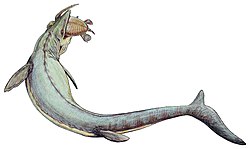Top Qs
Timeline
Chat
Perspective
New Egypt Formation
Geological formation in New Jersey From Wikipedia, the free encyclopedia
Remove ads
The New Egypt Formation is a Late Cretaceous (late Maastrichtian-aged) geologic formation of the Monmouth Group in New Jersey, United States.[1]
Remove ads
Description
Summarize
Perspective
The basal New Egypt is a massive clayey, glauconitic marl that closely resembles the Navesink Formation into which it grades below. Ammonites and other invertebrates found at the Spheno Run site correlate well with the middle Severn Formation of Maryland. Spheno Run has so far produced a remarkable number of vertebrate specimens, especially from marine reptiles, including: carapace elements from at least two species of turtles, Peritresius ornatus and Taphrosphys sulcatus; various bone elements from at least two species of mosasaurs including a sizable fragment of dentary bone from Prognathodon rapax and numerous shed teeth from Mosasaurus maximus.
Vertebrate remains also include material from sharks, particularly teeth and unusually large vertebral centra from an individual lamniform shark Squalicorax pristodontus, bony fish, and, rarely, dinosaurs. In addition to the vertebrate collection, Spheno Run also yields an abundance of invertebrate species including: twenty-two bivalves, seven gastropods, six cephalopods, and one each of echinoidea, porifera, and scaphopoda. It is rare to find such an extensive array of both vertebrate and invertebrate species within one horizon in New Jersey.[1][2]

The New Egypt Formation preserves the most complete late Maastrichtian-aged dinosaur fauna from the eastern United States, providing an important record of the dinosaurs that inhabited Appalachia around this time. These remains belong to dinosaurs whose carcasses were washed out to sea, and preserve evidence of being submerged in water and scavenged by sharks & marine invertebrates. The most notable taxon from this formation is the tyrannosauroid Dryptosaurus, one of the few predatory theropods known from eastern North America. In addition, remains of indeterminate hadrosaurs, including potential lambeosaurines, are also known. The potential presence of lambeosaurines is notable, as very few other remains are known from eastern North America, and is not thought to have still inhabited North America so late into the Maastrichtian.[3][4]
Remove ads
Vertebrate paleobiota
Summarize
Perspective
Cartilaginous fish
The following taxa are known:[5]
Chimaeras
Sharks
Rays
Ray-finned fish
Reptiles
Dinosaurs
Crocodylomorphs
Turtles
Squamates
Invertebrate fossils
- Bivalves
- Cephalopods
Remove ads
See also
References
Further reading
Wikiwand - on
Seamless Wikipedia browsing. On steroids.
Remove ads

























